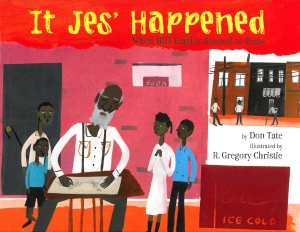Join us for a critical webinar on Wednesday, January 15th at 4:00 PM EST about using children’s literature and nonfiction to teach about slavery. We will discuss and demonstrate with award-winning titles to support your approach in teaching this complex, under-taught period of American history, with special focus on historical accuracy and culturally responsiveness. Katie Potter, Lee & Low’s Literacy Specialist, Dr. Amanda Vickery, Assistant Professor of Social Studies Education at the University of North Texas, and Dr. Noreen Naseem-Rodriguez, Assistant Professor of Elementary Social Studies at Iowa State University, will discuss different pedagogical approaches, classroom activities, and books that approach slavery in elementary and middle school spaces so that teachers, librarians, and other professionals are aware of harmful stereotypes and inaccurate information when teaching about slavery.
Tag Archives: slavery
Interview: New Voices Award Winner Rita Lorraine Hubbard on Writing a Picture Book Biography
 At Lee & Low Books we are always interested in biographies of unsung heroes. Stories of lesser-known individuals who used their talents and overcame obstacles to achieve their dreams and serve their society fill our shelves of published titles. Each year our New Voices Award judges consider dozens of biographical submissions on the lookout for a winning combination of compelling characters and well-researched storytelling. In this blog post, we interviewed Rita Lorraine Hubbard, the 2012 New Voices Award winner, about her biography Hammering for Freedom: The William Lewis Story, which tells the story of William “Bill” Lewis, an enslaved man who earned enough money being a blacksmith and set a daring plan in motion: to free his family. Continue reading
At Lee & Low Books we are always interested in biographies of unsung heroes. Stories of lesser-known individuals who used their talents and overcame obstacles to achieve their dreams and serve their society fill our shelves of published titles. Each year our New Voices Award judges consider dozens of biographical submissions on the lookout for a winning combination of compelling characters and well-researched storytelling. In this blog post, we interviewed Rita Lorraine Hubbard, the 2012 New Voices Award winner, about her biography Hammering for Freedom: The William Lewis Story, which tells the story of William “Bill” Lewis, an enslaved man who earned enough money being a blacksmith and set a daring plan in motion: to free his family. Continue reading
Interview With Joseph McGill, Founder of the Slave Dwelling Project
 Today on the blog we are honored to be able to interview Joseph McGill, Founder of the Slave Dwelling Project, which works to preserve extant slave dwellings and organizes overnight stays in them to bring attention to the history and experiences of enslaved people. Welcome, Mr. McGill! Continue reading
Today on the blog we are honored to be able to interview Joseph McGill, Founder of the Slave Dwelling Project, which works to preserve extant slave dwellings and organizes overnight stays in them to bring attention to the history and experiences of enslaved people. Welcome, Mr. McGill! Continue reading
Three Ways to Teach Etched In Clay by Andrea Cheng
 Jill Eisenberg, our Resident Literacy Expert, began her career teaching English as a Foreign Language to second through sixth graders in Yilan, Taiwan as a Fulbright Fellow. She went on to become a literacy teacher for third grade in San Jose, CA as a Teach for America corps member. She is certified in Project Glad instruction to promote English language acquisition and academic achievement. In her column she offers teaching and literacy tips for educators.
Jill Eisenberg, our Resident Literacy Expert, began her career teaching English as a Foreign Language to second through sixth graders in Yilan, Taiwan as a Fulbright Fellow. She went on to become a literacy teacher for third grade in San Jose, CA as a Teach for America corps member. She is certified in Project Glad instruction to promote English language acquisition and academic achievement. In her column she offers teaching and literacy tips for educators.
1. Teaching Students About Narrator Bias
Etched In Clay is a compelling case study for narrator bias and trustworthiness. The text structure with 13 narrators and its economy of words make Dave’s story captivating, especially to middle grade  students who are beginning to engage with primary sources from the period of American slavery. Students can analyze how each speaker’s social experiences, status, motivations, and values influence his/her point of view, such as evaluating the poems of the slave-owners who would have had a vested interest in popularizing a particular narrative of slavery.
students who are beginning to engage with primary sources from the period of American slavery. Students can analyze how each speaker’s social experiences, status, motivations, and values influence his/her point of view, such as evaluating the poems of the slave-owners who would have had a vested interest in popularizing a particular narrative of slavery.
Using multiple perspectives to tell the story of one life is a striking display of how events can be interpreted and portrayed by different positions in the community. Students face the task of examining the meaning and nuance of each narrator (13 in total!) and what they choose to convey (or don’t).
Poetry Friday: “A Poem!” from Etched In Clay
 Andrea Cheng is the author of several critically-acclaimed books for young readers. Her most
Andrea Cheng is the author of several critically-acclaimed books for young readers. Her most ![]() recent novel, Etched in Clay, tells the story in verse of Dave the Potter, an enslaved man, poet, and master craftsperson whose jars (many of which are inscribed with his poetry and writings) are among the most sought-after pieces of Edgefield pottery. Etched in Clay recently won the Lee Bennett Hopkins Poetry Award.
recent novel, Etched in Clay, tells the story in verse of Dave the Potter, an enslaved man, poet, and master craftsperson whose jars (many of which are inscribed with his poetry and writings) are among the most sought-after pieces of Edgefield pottery. Etched in Clay recently won the Lee Bennett Hopkins Poetry Award.
April is National Poetry Month, so we asked author Andrea Cheng to share one of her favorite poems from Etched in Clay:
FEATURED POEM
Etched in Clay, p. 65
A Poem!
What does Passover celebrate?
Tonight marks the first night of Passover, so I thought I’d share a bit about what the holiday celebrates and what it means to me. Passover is one of the most important Jewish holidays of the year, and is probably the most observed Jewish holiday after Rosh Hashana and Yom Kippur (despite what people think about Hanukah!). 
Passover commemorates the story of the Israelites’ exodus from Egypt, as told in the old testament (or, if you’re the kind of person who waits for the movie to come out, as told in The Ten Commandments). According to the story, the Israelites were enslaved in Egypt for 400 years, until God, with the help of Moses, led them out of Egypt and into freedom.
Black History Month: Why Remember Bill Traylor?
![]() Everyone knows Frederick Douglass and Martin Luther King, Jr., but there are many other African Americans who have contributed to the rich fabric of our country but whose names have fallen through the cracks of history.
Everyone knows Frederick Douglass and Martin Luther King, Jr., but there are many other African Americans who have contributed to the rich fabric of our country but whose names have fallen through the cracks of history.
We’ve asked some of our authors who chose to write biographies of these talented leaders why we should remember them. We’ll feature their answers throughout Black History Month.
Today, Don Tate shares why he wrote about Bill Traylor in It Jes’ Happened: When Bill Traylor Started to Draw:
Why the Lee & Low staff walked 12 miles
Last fall, some of the staff at Lee & Low wanted to find out what it was like to walk twelve miles. Why? We were inspired by the feat that Frederick Douglass’ mother accomplishes in Love Twelve Miles Long by Glenda Armand and Colin Bootman: she walks twelve miles by night to visit her son. As happened often with slave families, Frederick was separated from her at birth and sent to live on another plantation, so this was the only way that he was going to be able to see her.
So, one brisk November morning, four of us met near Wall Street to begin a journey that would take us all day. Honestly, the longer that the trip took, the more we realized what an incredibly daunting task this actually was. When we started the walk, we figured it would take a few hours, but imagined that we would be back in the office in time for a well-deserved lunch.




